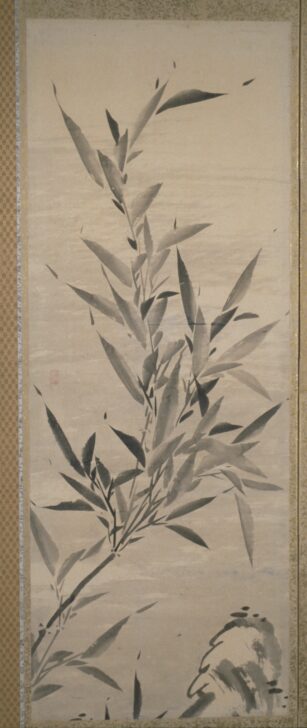Scholarly Occupations and The Three Friends (Pine, Plum, Bamboo)
Ikeno Taiga

Description
Subject Matter:
"The panels of these screens alternate human figures and plants. The figures illustrate various activities of the scholar's life. The plants are known collectively as The Three Friends, shochikubai, because they all prosper during the winter season. The pine and bamboo remain evergreen while the plum blossoms when snow is still on the ground.
On the first panel of the right screen. the first six lines of a poem by the famous Tang dynasty poet, Li Po (701-762) is inscribed. The poem is entitled "Requesting Ts'ui Shan-jen's Painting of the Waterfall at the Thousand-foot Cliff."
The thousand-foot white cliff is split
The red walls of four mountains open
The dragon pond shoots and spits in the middle
Day and night it produces wind and thunder
One can also see the cascading waterfall
Resembling the gathering of the Milky Way
The Thousand-foot Cliff is located on Mt. T'ien-t'ai in Chekiang province. In the midst of four peaks is the famous waterfall mentioned in the poem. This scene is cleverly depicted as a painting within a painting on this panel."
"The left screen begins with a section of the trunk of a pine tree that appears as though it could be the lower part of the same pine shown in the right screen. Written in wild cursive script above a smiling scholar holding his beloved musical instrument, the ch'in, is the first half of a poem by Po Chu-i (772-843) entitled "Remembering Hui-shu."
Roaming the hills and scattered streams with a book of poems.
Viewing the moon and searching for flowers while grasping a wine cup.
The Six Concerns exhaust my thoughts: I wish you were my companion.
When will you return to Lo-yang?
In choosing only the first two lines of the poem above. the artist chose to emphasize the happy aspect of the ideal literati life style and neglected the longing of the poet for his absent friend Ts'ui Hsuan-liang, whose style name was Hui-shu."
As for the scenes with the scholar witing the maxims and the drunken scholar, "frequently scenes of this type are intended to represent Li Po. the poet of the verse found on the opening panel of the right screen. If it is he who is intended here, Taiga has cleverly unified the twelve panels with a reference to the same poet.
The plump, humourous figures portrayed in these screens are arranged in poses that can be seen frequently in Taiga'sfigure paintings. Taiga's idiosyncratic style of figure painting was developed in part under the influence of Chinese paintings that followed the style of the Yang-chou eccentric. Huang Shen (1687-ca. 1766).
Taiga's nearly incredible inventiveness and versatility allowed him to paint in a wide variety of styles, from highly detailed paintings with striking color tones to quickly painted studies in ink. These screens confidently display the variety of Taiga's subject matter, brushwork, and compositions during the last decade of his life."
Adams, Celeste, and Paul Berry. Heart, Mountains, and Human Ways: Japanese Landscape and Figure Painting: a Loan Exhibition from the University of Michigan Museum of Art. Museum of Fine Arts, 1983.
Physical Description:
"The panels of these screens alternate human figures and plants. The figures illustrate various activities of the scholar's life."
On the first panel of the right screen, "a rotund scholar sits on the ground viewing the waterfall described in the poem ["Requesting Ts'ui Shan-jen's Painting of the Waterfall at the Thousand-foot Cliff" by Li Po], while his young assistant, who is holding the painting up on a rod, peeps around the edge of the scroll. "
"The next panel has a bold composition of flowering plum branches. The wide brush strokes of the limbs are typical of Taiga's technique for plum paintings. Hidden amidst the branches in the lower right corner is Taiga's signature, Kasho, or Woodcutter of the Mists. The third panel reveals several scholars contentedly dozing against a boulder whose flattened top has been inscribed with lines for the game of go. One scholar has awakened in time to signal his attendant for a cup of tea. The succeeding panel depicts a sweeping bough of a pine tree, while the fifth panel portrays three scholars read ing hand scrolls. The final painting of the right screen is filled with a dynamic branch of bamboo twisting over a rock which projects into the lower right corner.
The left screen begins with a section of the trunk of a pine tree that appears as though it could be the lower part of the same pine shown in the right screen. Written in wild cursive script above a smiling scholar holding his beloved musical instrument, the ch'in, is the first half of a poem by Po Chu-i (772-843) entitled "Remembering Hui-shu.""
"The third panel presents the mid-section of two enormous bamboo. In the next composition a scholar is writing a four character maxim on a fan while his attendant looks on. The second painting of flowering plum branches has an exuberant feeling, echoing the flowers seen in the first example. The screen concludes with a scene of a drunken scholar being supported by friends and attendants."
Adams, Celeste, and Paul Berry. Heart, Mountains, and Human Ways: Japanese Landscape and Figure Painting: a Loan Exhibition from the University of Michigan Museum of Art. Museum of Fine Arts, 1983.
Similar to 1961/1.174
Usage Rights:
If you are interested in using an image for a publication, please visit https://umma.umich.edu/request-image/ for more information and to fill out the online Image Rights and Reproductions Request Form.